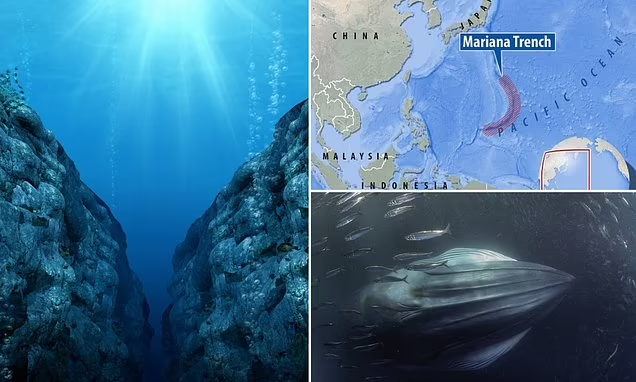- A new, complex whale call, named the “Western Pacific Biotwang,” has been recorded in the Mariana Trench.
- The call features a wide frequency range, from deep moans to a metallic finale, and lasts 2.5 to 3.5 seconds.
- It resembles the “Star Wars” call of dwarf minke whales but was recorded year-round, raising questions about its purpose.
- Researchers hope to confirm the source of the call through further acoustic, genetic, and visual studies.
- The discovery highlights the value of passive acoustic monitoring in understanding elusive marine species.
Researchers from Oregon State University (OSU) have identified a unique and complex sound in the Mariana Trench, believed to be a previously undocumented call from a baleen whale.
Dubbed the “Western Pacific Biotwang,” this call stands out for its wide frequency range and intricate structure, offering new insights into the behavior and distribution of these elusive marine giants.
A Unique and Mysterious Sound
The Western Pacific Biotwang lasts between 2.5 and 3.5 seconds and consists of five distinct parts. It begins with deep moans at frequencies as low as 38 hertz and ends with a metallic, high-pitched finale reaching up to 8,000 hertz.
“It’s very distinct, with all these crazy parts,” said Sharon Nieukirk, a senior faculty research assistant in marine bioacoustics at OSU. “The low-frequency moaning part is typical of baleen whales, but it’s that twangy, metallic sound that makes it truly unique. We don’t often discover new baleen whale calls.”
The call was recorded using passive acoustic ocean gliders—autonomous instruments capable of diving up to 1,000 meters and operating for months at a time. These gliders captured the sound in the Mariana Trench, the deepest part of the world’s oceans, located between Japan and Australia with depths exceeding 36,000 feet.
Similarities to Known Whale Calls
The Western Pacific Biotwang bears a striking resemblance to the “Star Wars” call produced by dwarf minke whales in Australia’s Great Barrier Reef. Like other baleen whales, minke whales use baleen plates in their mouths to filter krill and small fish from seawater. They are known for their regionally specific calls, such as the “boings” in the North Pacific and low-frequency pulse trains in the Atlantic.
However, minke whales are notoriously difficult to study. They are the smallest baleen whales, spend little time at the surface, and often inhabit areas with rough seas, making visual sightings challenging. Their frequent vocalizations, though, make them ideal subjects for acoustic research.
Unanswered Questions
While the Western Pacific Biotwang shares similarities with the Star Wars call, researchers cannot yet confirm its source. Additionally, the call raises intriguing questions about its purpose. Baleen whale calls are often associated with mating and are typically heard during winter months. Yet, the Western Pacific Biotwang was recorded year-round.
“If it’s a mating call, why are we hearing it throughout the year? That’s a mystery,” said Nieukirk, who is part of the Cooperative Institute for Marine Resources Studies, a collaboration between OSU and NOAA’s Pacific Marine Environmental Laboratory. “We need to determine how often this call occurs in different seasons and how widely it’s distributed.”
Challenges in Detection and Future Research
The call’s wide frequency range makes it particularly challenging to detect when analyzing recorded sound data. Traditional acoustic analysis focuses on narrower frequency ranges, which could cause researchers to miss portions of the Western Pacific Biotwang.
“Now that we’ve published these findings, we hope other researchers can identify this call in past and future data,” Nieukirk explained. “Ultimately, we aim to pinpoint the source of the sound. To do that, we need more data—genetic, acoustic, and visual—to confirm the species and understand how this sound is used.”
Nieukirk and her team hope to mount an expedition to locate the animals producing the call, collect biopsy samples, and unravel the mystery behind this “amazing, weird sound.”
A Step Forward in Marine Science
The discovery of the Western Pacific Biotwang highlights the importance of passive acoustic monitoring in studying elusive marine species. As technology advances, researchers can uncover new aspects of whale behavior and communication, even in the most remote and inhospitable parts of the ocean.
This finding not only adds to our understanding of baleen whales but also underscores the need for continued exploration and conservation of the deep sea. As Nieukirk puts it, “Good science will explain it,” and with further research, the secrets of the Western Pacific Biotwang may soon be revealed.


